By Larry Case
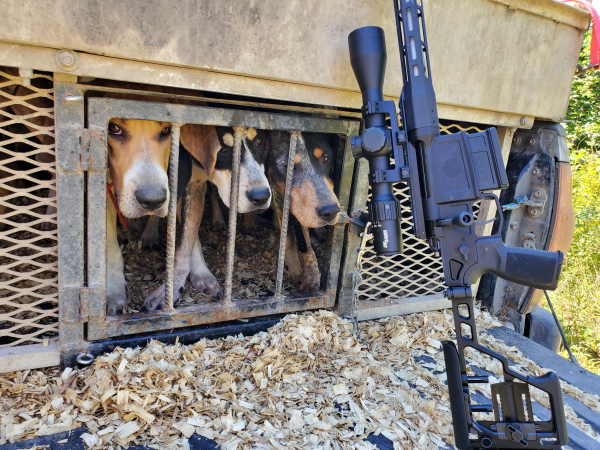
Struggling to keep going up the mountain, I notice that I am stumbling more. My breath is ragged, but I keep advancing. I can hear the wild chorus of the bear hounds baying above me, but we don't seem to be getting much closer. One of the hunters in the line trudging up the hill looks over and says, "You OK?" I nod like, "Yeah, I'm fine." Up the hill and far ahead of me, I can see Kish scrambling up the slope. The steep incline and the distance we have traveled don't seem to affect him. I grimace and keep putting one foot in front of the other. I need to stop and cinch my boots up tighter and take a quick breather, but I will not stop. The hounds have a bear treed up there, and the ancient draw of hunters to hounds pulls me up the hill. I will not stop.
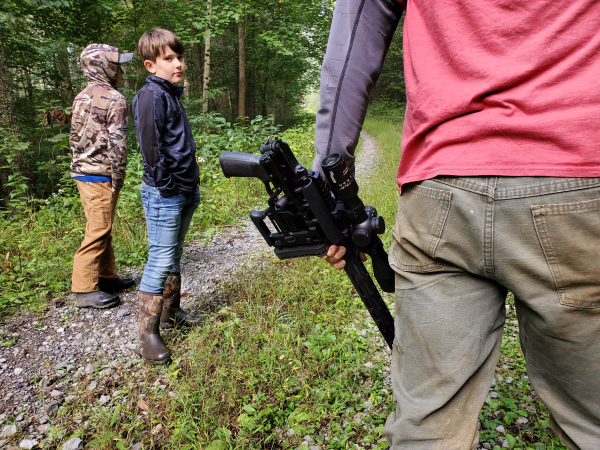
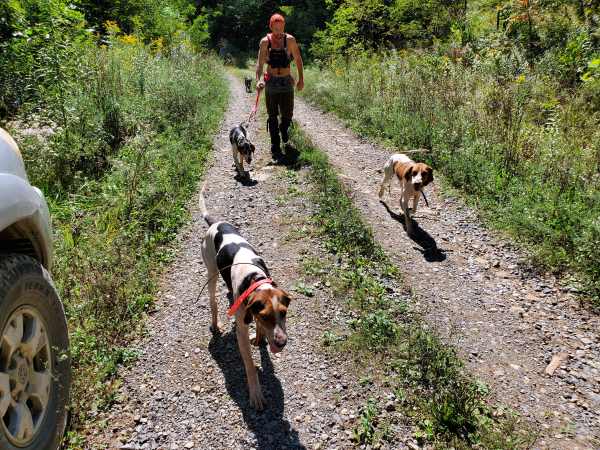
Kish Justice is a bear hunter. Some hunters sometimes hunt bears, and then there are bear hunters. Kish is a bear hunter. Born and bred in the Appalachian Mountains, he was introduced to bear hunting, with hounds, at a young age. At fifteen, he was invited to come along with some local bear hunters. That day he was cast into the wild melee of a large bear bayed on the ground. Having no idea what to do, he heard one of the hunters yelling at him, "Get in there boy, and leash some dogs before they all get killed!" "The pure adrenaline rush at that point is almost indescribable," Kish remembers. "The hounds were screaming and fighting the bear right in my face, and I had never seen anything like it. I was hooked."
The die was cast, his fate was decided, he was going to be a bear hunter. Mr. Justice is certainly not alone in this regard. There are bear hunters in many areas of West Virginia, especially here, in the higher elevations of the Alleghenies, an area with lots of bears and the room to chase them.

It's an old tradition in a wild country. For the uninitiated to begin to understand this type of hunting, you must realize how much area it takes to pursue bears with hounds. When bear dogs strike a bear track, the chase can go for miles through some of the roughest terrain imaginable. Along with some very steep hillsides to negotiate, the bear hunter will usually be faced with some very thick brush, rocks, downed logs, and other obstacles that seem to make your way impassable.
Justice has been steeped in a hunting tradition for this area that goes back to colonial times. The first brave hunters and settlers that came west of the Alleghenies found a wealth of game in the mountains, including bears. Black Bears were plentiful and were an important food source and trade item to the early settlers in the mountains. Bear meat was highly prized, and even more important was the use of rendered bear fat, which could be used in cooking, protecting leather items, burning it in oil lamps, and everything from skincare to lubricating metal hinges. Bear hides were bought, sold, and bartered to be used for leather and other goods.
If you don't have good dogs, stay in the truck. These early hunters knew one of the best ways to successfully take bears in the mountains was with dogs, usually hounds. Early bear hunters quickly started to develop a bear hound that not only had a good nose for trailing, as most hounds do, but they had to have great stamina to run long races in the mountains, and they had to have something else, grit. Bear hunters will often use the term "gritty" for the trait in hounds that gives them the nerve to stay with a bear when the dogs get in close quarters with a bruin. Without the desire for a hound to fight a bear, the dogs could never make the bear climb a tree until the hunters arrive, or "bay" the animal if he refuses to climb a tree. The bear that stays on the ground and refuses to climb a tree (often a big bear) can be a problem and will often hurt some of the dogs, sometimes killing them.
Kish Justice and some of his hunters have developed their line of bear hounds over the years. The area they hunt, the higher elevations near Richwood, West Virginia, has many timber company land, which means many clearcuts. As they grow up, these areas provide some excellent bear habitat, but they can be tough to traverse for hunters and dogs. "There are some good bear dogs that hunt mostly open woods like National Forest," Kish explained, "but where we hunt most of the time, around these clear cuts, the dogs have to be fast to catch a bear. They have to be fast and have no quit in them, that is what we look for," he said. This describes his best bear hound, "Dirty", which he says had it all from the very start. "Dirty is fast, has a good nose, and will not quit once he has started a bear track." "He was born a bear dog", Kish said.
Some people are born to be bear hunters; I think to myself, I watch Kish speed down a narrow mountain road. He is driving his Toyota truck bear hunting rig while intently watching the chase and several dogs on his hand-held Garmin dog locator. I watch to see if he will occasionally actually look up at the road. He does, and I think what an excellent commercial this would make for the evils of distracted driving but say nothing. I recognize a man in his element, and he is doing what he was meant to do, following a pack of bear dogs. There is nowhere else on God's green earth he would rather be.
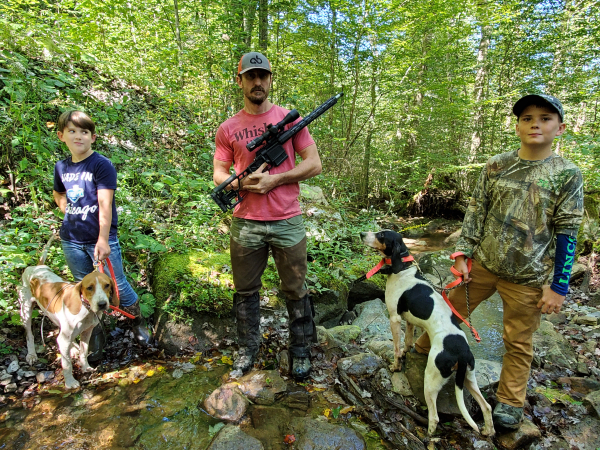
Kish's ten-year-old son Anse Justice and twelve-year-old buddy Cade Clemens are in the back seat. Both have been bear hunting since they were toddlers, and both have taken multiple bears, including a four hundred and an eighty-two-pound giant that Cade shot a few years ago. They take the breakneck chase around these twisting roads all in stride. They know at any second Kish could come to a sliding stop, jump out of the truck, and yell something like "Six hundred yards down this drain!" "I think they are bayed in a big rock pile down there!" "We gotta get there quick!"
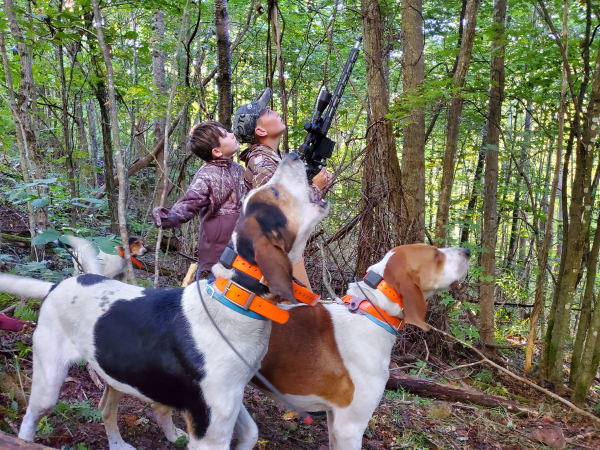
Kish does not have to tell me that once we get there, the bear may very well "quit the country." That means take off running and cross a distance ridge with dogs in tow; you may see him hours later, or never again.
For the love of the chase. For the dedicated group that Kish hunts with, it’s all about the dog and the pursuit. Many people are surprised to learn that the hard-core bear hunters who own the dogs may rarely kill a bear during the season. It is common for a young hunter or an adult to tag along and be available to take the shot if the dogs tree a bear. To the first-time bear hunter and especially a youngster, this will be hunter's memory they will keep forever. This group of hound hunters are more than happy to accommodate someone that wants to take a bear, and they love the chase.
This type of hunting, running bears with hounds, is not so much a hunting style as it is a lifestyle. Keeping a pack of bear dogs, the feeding, training, conditioning, and caring for several hounds is almost a full-time job. These hunters run their dogs nearly year-round; any hound kept in the pen most of the time and only released during the season is going to be severely limited in ability.
After running this bear for half of the day, he has finally decided to climb a tree. When we leave the truck, I hear that this one "isn't very far", which is an "easy one." It turns out it is over a mile to the tree (maybe two?), and while some of it is relatively level for this country, the final ascent to the tree is not. I arrive late to the party but witness the wild scene at the tree, most of the dogs have been tied back already, but their baying is almost deafening.
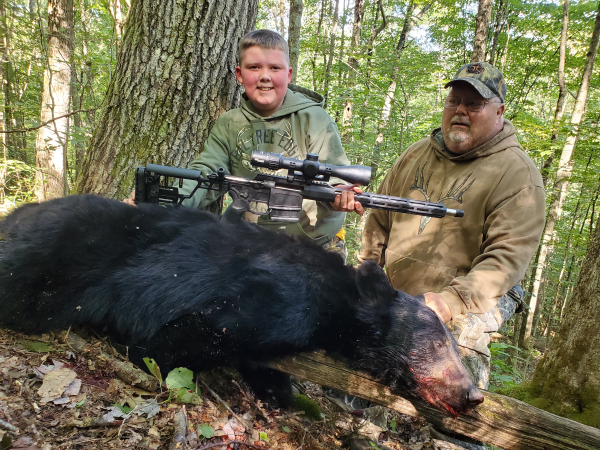
Eleven-year-old Nathaniel Hamrick from Craigsville, West Virginia, is here, and along with his Grandad, Gary Milam has made the long trek to the tree. Nathaniel is shooting the Sig Sauer Cross rifle, chambered in .308, and with Kish's assistance, settles into a shooting position just uphill from the tree. While trying to shoot pictures of all this, I note that Nathaniel's surprisingly calm and confident about all this. The bear slides out of the tree at the shot, it's a perfect shoulder shot, and the bear may have been dead when he hit the ground. I'm not sure who is the proudest, Nathaniel, or his Grandad. I'm betting they will remember this day for a long time.
The gun. I was less than enthusiastic about the Sig Sauer Cross rifle for this bear hunt under full disclosure. No doubt I am a traditionalist when it comes to firearms, and looking at the chassis rifle concept, I was not getting it, and the foldup stock thing, what was that about? All of this changed very quickly.
Sighting in and shooting the rifle before the hunt you immediately notice the lightweight and the "handiness". At 6.5 pounds, this rifle is definitely in the bantamweight class and as I have said many times before, you carry a firearm a lot more while hunting than you shoot it. Weight is important. Adding a scope adds to the weight depending on the optic choice, more on this later. In truth, I have always been a fan of a two-stage trigger and found the trigger on the Cross rifle to be excellent. Kish Justice, the bear hunter, liked it from the first round fired.
The weight and handiness that is overall ease that the rifle can be carried and handled was not lost on this bear hunting crowd in the mountains. These guys know all about the need for a firearm to be light in weight and easily carried in the God-awful country they traverse on a bear chase. When I first brought out the Sig Sauer Cross rifle for their scrutiny, I was surprised. To a man, everyone I handed the gun to in two days in the mountains liked it. They liked the weight, the ease it could be carried, and again, that handy word. I wondered how the foldup stock would fare with this group, but they embraced it immediately. This group of bear hunters instantly saw what I did not. If you are going to carry a firearm all day in this kind of terrain, the ability to fold the stock and shove the gun in a backpack is a big plus. They loved this feature.
The rifle we carried on this hunt was chambered in .308 Winchester, which was plenty for black bears, and the Cross rifle is also available in 6.5 Creedmoor and .277 Fury. The ammo chosen was the Hornady Black .308 with a 155-grain A-Max bullet. This ammunition fed and cycled in the Cross rifle with no problems and all indications performed flawlessly on black bear.
I might have said that we chose a little too much scope for this venture in that the Sig Sauer Sierra 3 BDX 4.5-14X44mm may be a little big for what we needed. Scope size walks a fine line for this type of hunting; while most of the shots are taken at the short range of a treed bear, it is possible for the hunters to try shots for a bear on the ground as they cross and area in front of standers. The ranges here could be fifty to two hundred yards, so this can make scope choice tricky.
The Sig Sauer BDX system is a wonder of modern technology., The BDX 2.0 means you can now choose an app-free easy set-up. If you desire to take your shooting to the next level of accuracy, then download our BDX smartphone app and configure your rangefinder riflescope for your exact ballistics and environmental characteristics. In other words, the range finder talks to the rifle scope! Or, if you prefer, BDX 2.0 also allows users to bond their rangefinders and sights quickly and easily with preset ballistic groups pre-loaded onto all BDX products that cover that vast majority of calibers on the market. These preset ballistic groups allow you to use BDX enabled products without using a smartphone app, so they are ready, right out of the box.
In the end, the Sig Sauer Sierra 3 BDX scope did its job without a hitch and believe me when I say we did not baby it. The scope and the rifle were carried over miles of less than kind terrain through brush, mud, sweat, and bear dog slobber. Add to this, it was continually pitched in and out of crowded trucks as the bear chases would go through different phases. The rifle and the scope got the full treatment. I gave both 4 ½ stars (I never give five stars).
There is a fire in these mountains—the fire of a group of hunters that purse a hunting heritage hundreds of years old. I saw young hunters here who hope to take this tradition and pass it along to their children and grandchildren. With any luck, the song of the bear hound will not fade from the mountains.